Go the extra mile
Towards a cooler planet
The environmental impact of current-generation electric vehicles, manufacturing and running
1 February 2023
Electric vehicles, or EVs, are becoming key in improving climate change. Big names like General Motors and Volvo are going all-electric, changing the car industry. The effect on the environment depends on how they're made and powered.
In 2021, about 10% of new cars and light trucks in the U.S. had electric motors. This shows a big move to cleaner cars. Sales of pure electric vehicles almost doubled, hitting 459,426 units. Electric motors are more efficient, and using renewable energy to power them is a big plus. But, we need to keep improving our power grids and making manufacturing better to fully reduce EVs' carbon footprint.
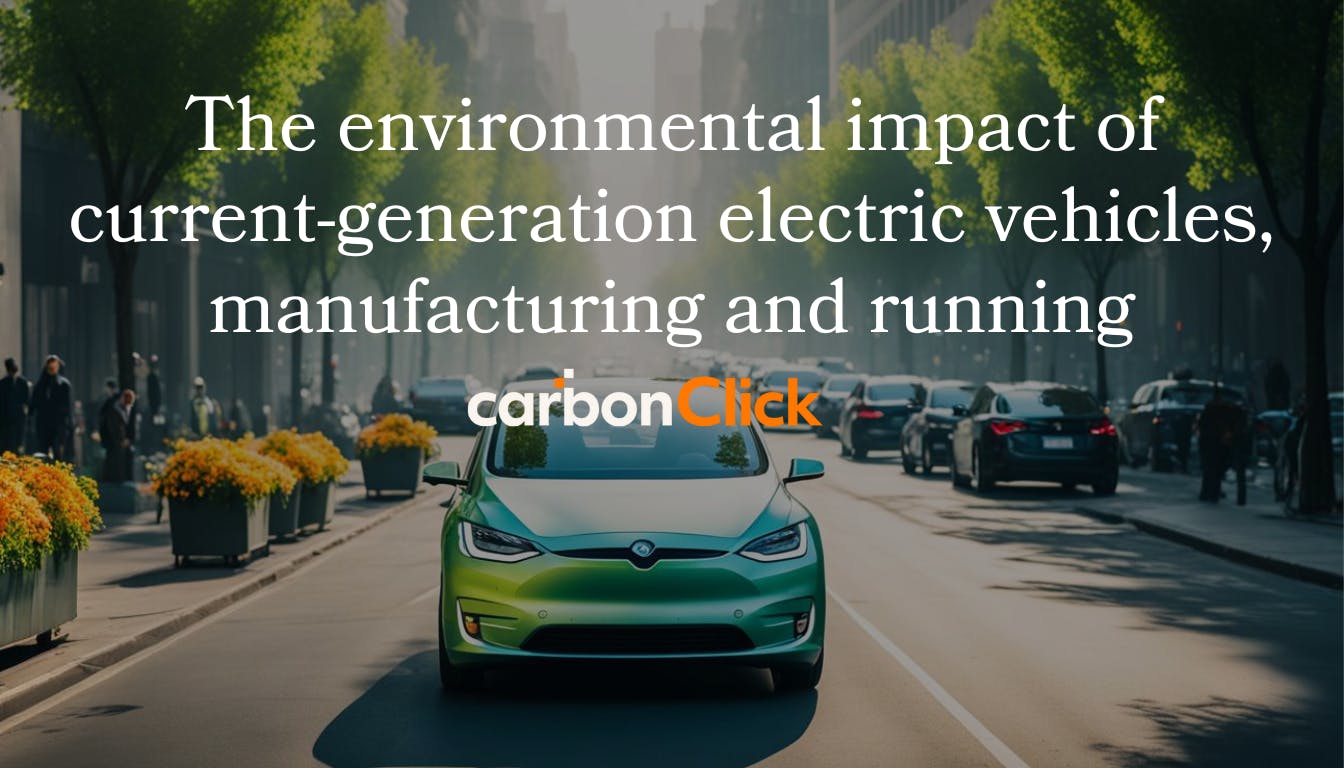
The environmental impact of current-generation electric vehicles, manufacturing and running
Building electric vehicles involves many steps, each with environmental issues. From getting raw materials to making batteries and putting the car together, we must do it with less harm to the planet. Making batteries is a big energy user and emits carbon, but we're working to make it better and cleaner.
Key takeaways:
- Electric vehicles can greatly cut down on carbon emissions compared to cars with traditional engines.
- The impact of EVs on the environment depends on how they're made and the power they use.
- Electric motors are getting more efficient, which helps reduce EVs' carbon footprint.
- The U.S. government offers incentives to encourage more people to buy EVs.
- General Motors and Volvo are leading the move to an all-electric future.
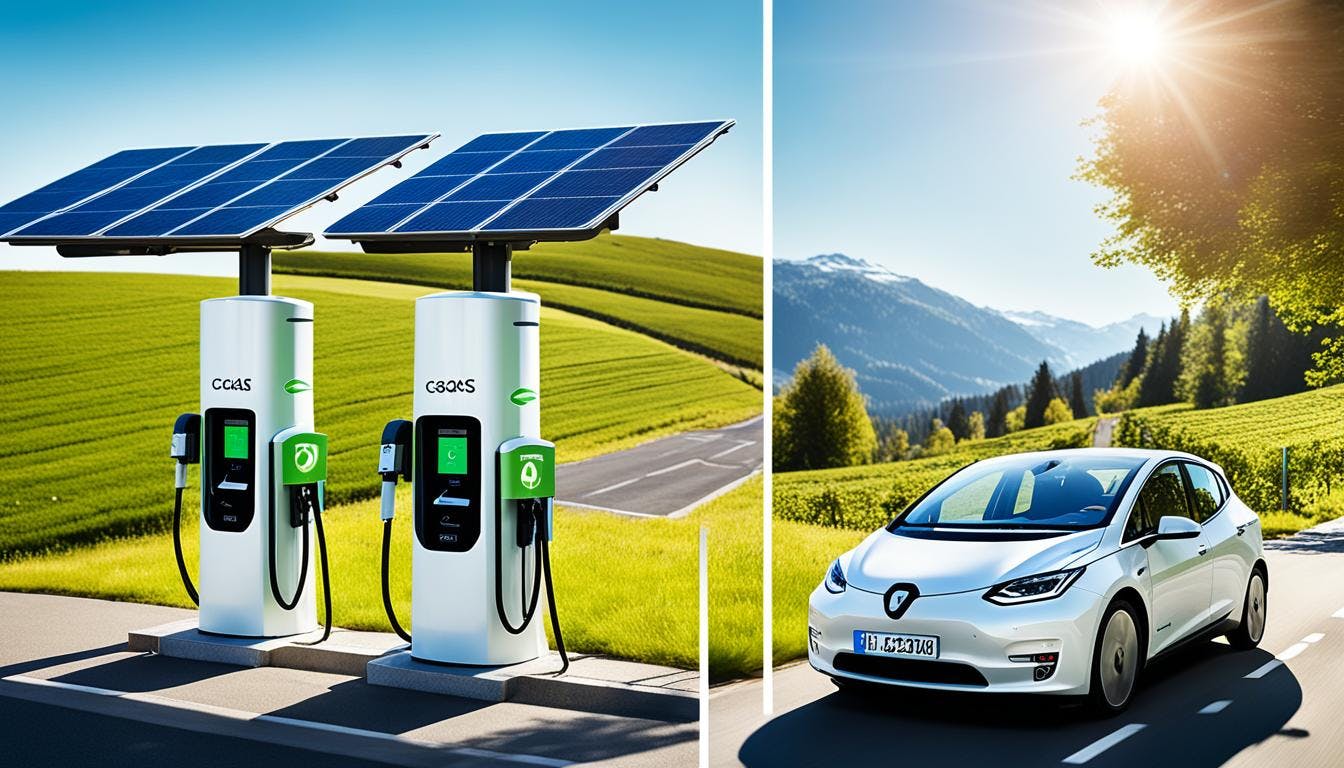
Introduction to electric vehicles and their Environmental Benefits
Electric vehicles (EVs), including Plug-in Hybrid Electric Vehicles (PHEVs) and Hybrid Electric Vehicles (HEVs), are key to our move towards renewable energy. In 2023, 23.6% of new cars in Europe were EVs, with 15.5% fully electric. This shows how more people are choosing these cars.
One big plus of electric cars is they produce less greenhouse gases than petrol or diesel cars. In Europe, electric cars emit 17-30% fewer greenhouse gases. This helps reduce our carbon footprint and meets goals to cut CO2 emissions from cars by 55% by 2030.
Norway leads the way with 89% of new cars being electric in 2022. Sweden and Iceland also have high rates, at 58% and 56% respectively. These countries are making big steps towards using energy-efficient transport.
Improving charging stations and managing electricity costs are key to more EVs. California plans to build 1.2 million chargers by 2030. This will help with the expected 7.5 million electric vehicles on its roads and support using more renewable energy.
Efforts to make electricity and electric vehicles more efficient aim for a 73% cut in emissions by 2050. This shows how electric vehicles can improve climate change and reduce carbon emissions globally.
Switching to EVs is not just good for one country. China leads in the New Energy Vehicle (NEV) industry with over 400 brands. It has sold more than three million electric vehicles, showing the global push for energy-efficient transport.
Understanding the manufacturing process of Electric Vehicles
Making electric vehicles (EVs) is a complex process. It starts with getting raw materials and ends with putting the car together. Each step is important for making EVs in a way that's good for the planet.
Raw Material Extraction and Environmental Concerns
Getting the materials needed for EVs, like lithium, cobalt, and nickel, is tough on the environment. It can harm habitats, pollute water, and affect local communities. The demand for these materials can also harm ecosystems, so we need to find ways to protect the environment.
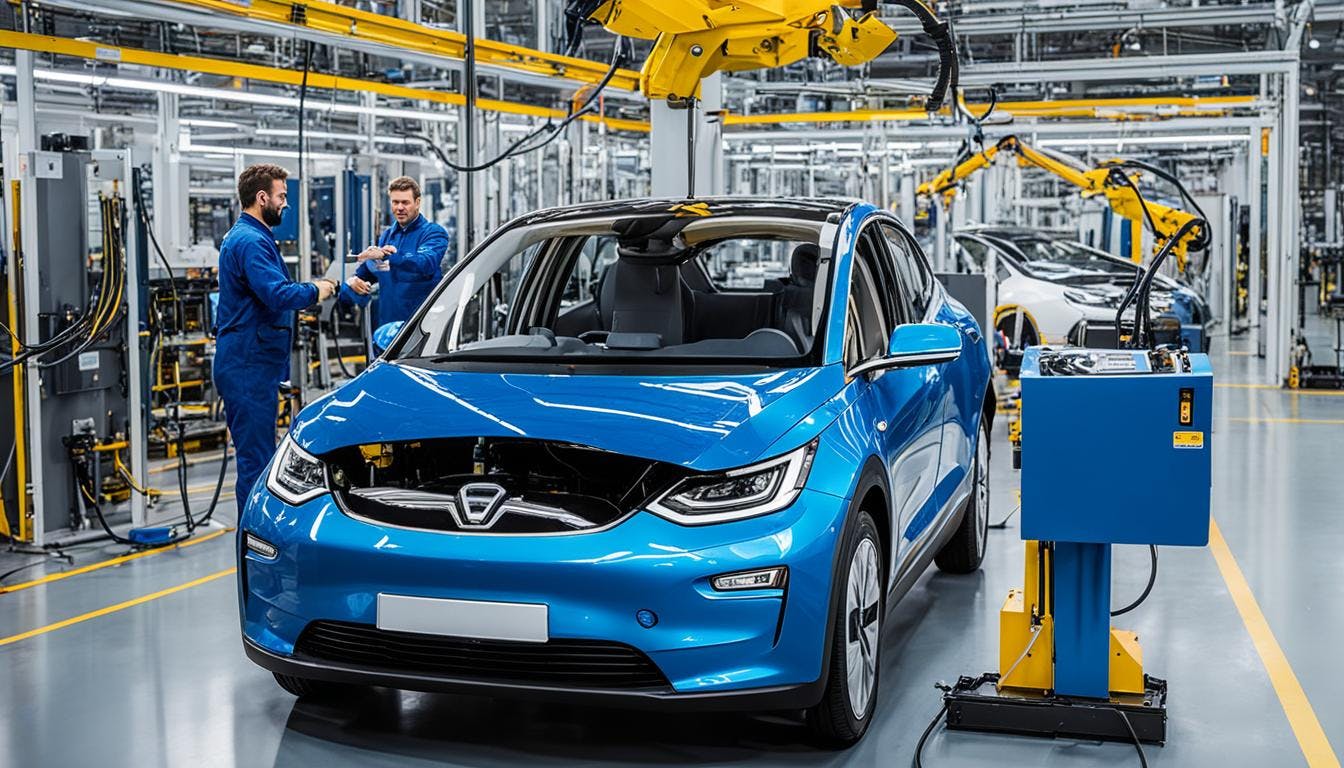
Copper mining alone consumes significant land, sometimes leading to the displacement of indigenous communities.
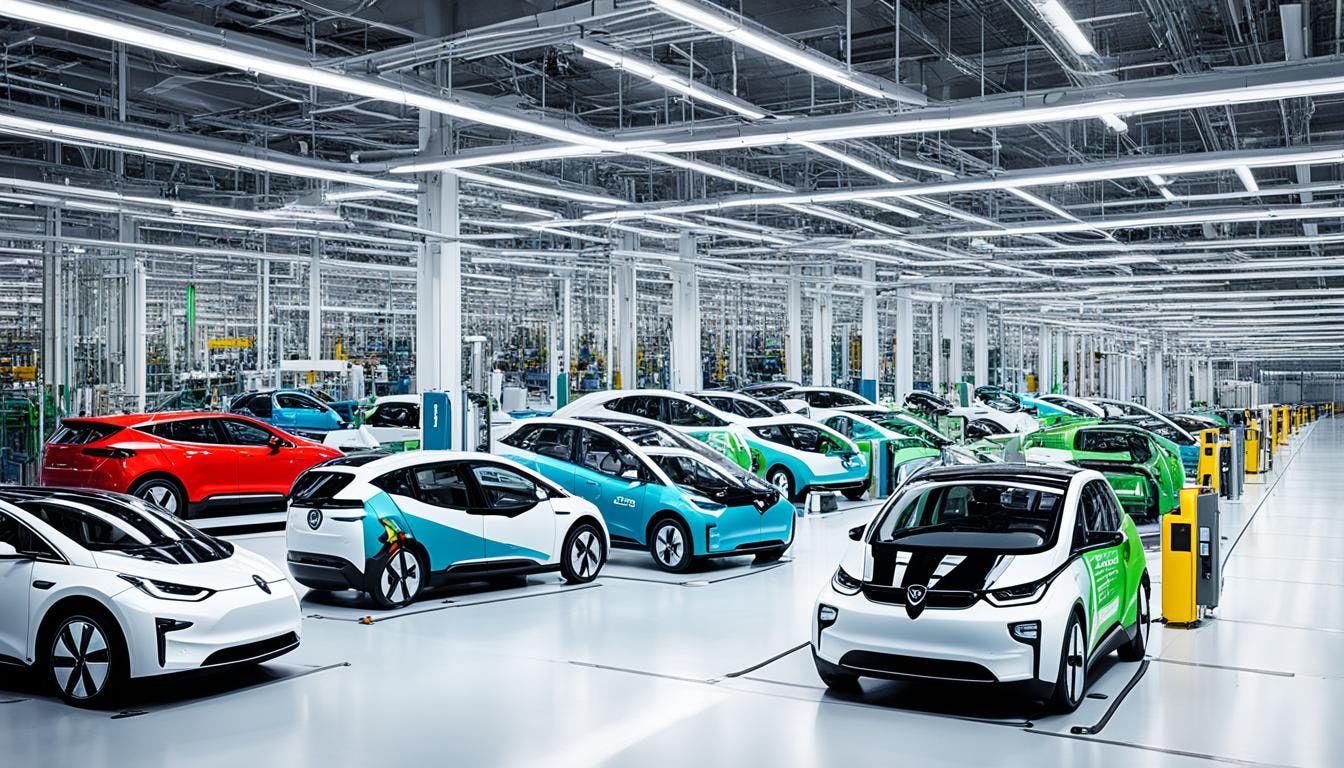
Challenges and environmental impact in Electric Vehicle Manufacturing
India is a big contributor to CO2 emissions, with about 291 million tonnes from Asian economies. This shows we need to be careful about how we get our materials and reduce emissions.
Battery Manufacturing and Associated Emissions
Making lithium-ion batteries for EVs needs a lot of resources and energy. This process creates a lot of greenhouse gases. For example, making one electric car in India can release almost 4 tonnes of CO2. But, EVs reduce this in just a few years, showing they're good for the planet.
EVs also use energy more efficiently than traditional cars. They lose 15% to 20% of energy, while old cars lose 64% to 75%. This shows we need to make battery production better and more sustainable.
Assembly and Production Line Challenges
Putting together electric vehicles has its own set of challenges, especially when making lots of them. We need to keep the environmental impact low during this stage. Making EVs uses a lot of water, which can harm habitats.
- Using sustainable materials is key to reducing harm to the environment.
- Using renewable energy in production cuts down on carbon emissions.
- Being careful with how we use land is crucial to avoid harming nature.
We need to keep finding new ways to make EV production better. By focusing on protecting the environment, we can make sure EVs are a positive change for the future.
Electric Vehicles and their Carbon Footprint
Electric vehicles (EVs) are a big step forward in reducing the carbon footprint. They have efficient motors and don't emit anything when running on electricity. Looking at their life cycle emissions shows how they're good for the environment.
Comparing EVs to Conventional Vehicles
EVs, plug-in hybrids, and hybrid electric vehicles all have much lower tailpipe emissions than traditional cars. EVs don't emit anything directly when using electricity. Traditional cars, however, release pollutants through their tailpipes and during evaporation.
The type of electricity used to charge these vehicles matters for their environmental impact. In places with clean energy sources, electric vehicles beat traditional cars in emissions.
Life Cycle Assessment of Electric Vehicles
A detailed life cycle assessment (LCA) helps us understand the full emissions of electric vehicles. It looks at emissions from fuel production and vehicle production, as well as when the vehicle reaches the end of its life. EVs usually have lower emissions over their entire life than cars with internal combustion engines. For example, in the UK, a Nissan Leaf EV emits about three times less per kilometre than an average conventional car.
However, the benefits of electric vehicles depend on how the electricity for battery production is made. Making batteries uses a lot of electricity, which affects the car's climate benefits. But, studies show electric cars are generally better for the environment than cars with traditional engines. They can be up to 43% less harmful to the climate than diesel cars.
To really cut down on carbon footprint, we should support low emission vehicles. We also need to invest in cleaner energy for powering these vehicles and making their batteries.
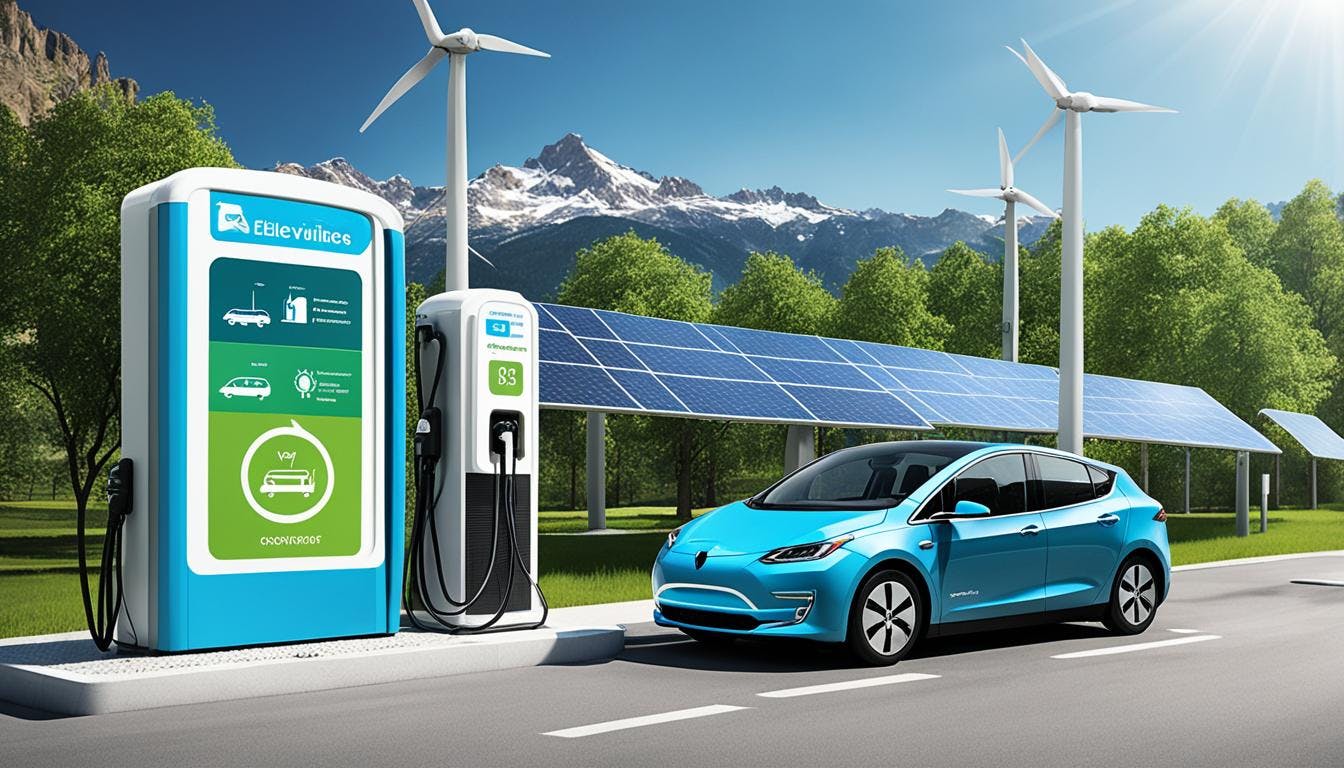
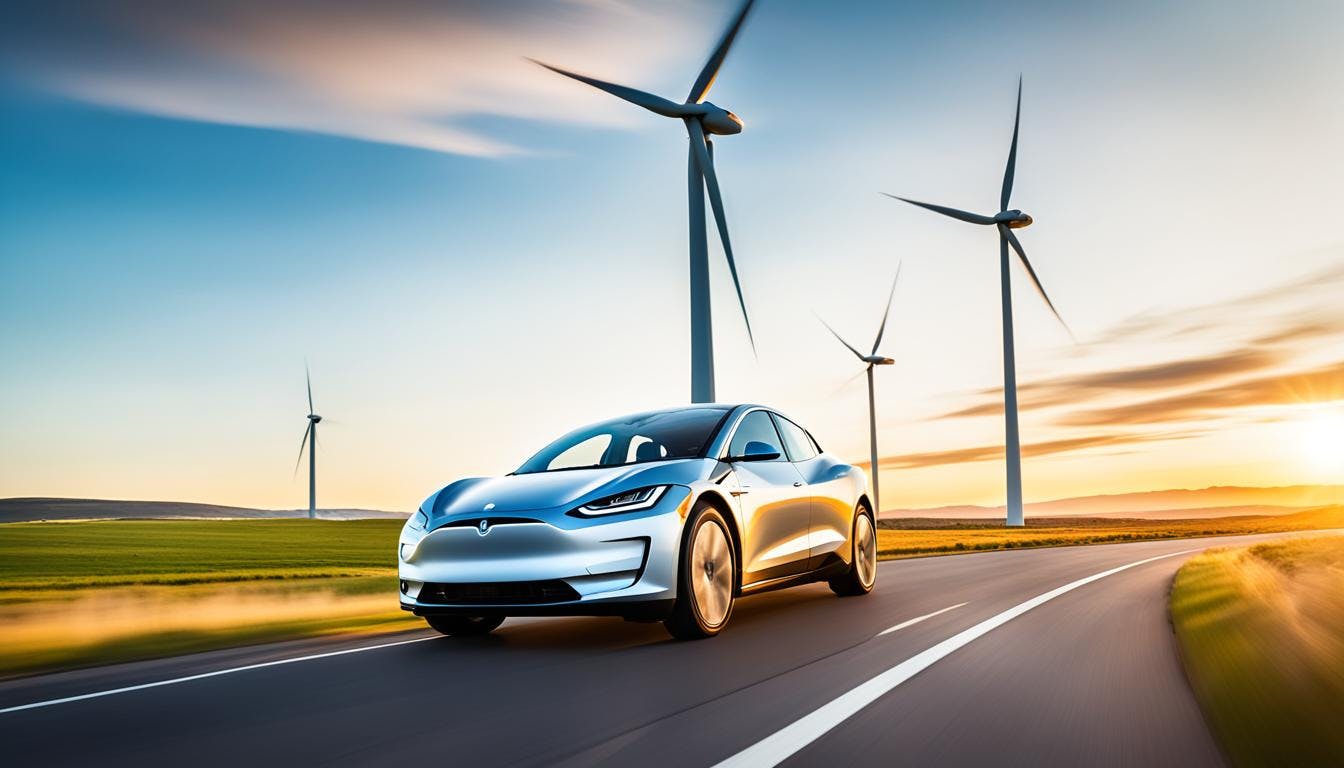
How Electricity generation impacts EV emissions
The emissions from electric vehicles (EVs) depend on the electricity source for charging. As more renewable energy is used, EVs become cleaner and more sustainable. This shift is moving us towards a better future.
Renewable Energy Sources and Their Advantages
Switching to renewable energy like wind, solar, and hydroelectric power is key to lowering EV emissions. In places with lots of clean energy, EVs have much lower emissions over their life. For example, in California, where renewable energy is widespread, EVs have big environmental benefits, reducing their impact on the planet.
Fossil Fuels vs. Clean Energy for EV Charging
Even so, using fossil fuels for electricity is still a problem. But, electric cars are about 50% better for the environment than traditional cars. Clean energy sources can greatly cut down emissions, making EVs a better choice.
The Role of Smart Grids in Reducing Emissions
Smart grids are vital for managing and improving how we use electricity. They connect renewable energy with traditional grids, making energy use more efficient and reliable. This reduces the carbon impact of EV charging. As technology gets better, smart grids will help us use more renewable energy, making our energy system stronger.
Investing in clean energy and technology is crucial for EVs to live up to their promise of a better future. With the Biden Administration’s $5 billion for EV charging stations, using smart grids and renewable energy will become easier and beneficial for everyone.
Running electric vehicles: Emissions and Efficiency
Electric vehicles (EVs) are becoming key in reducing emissions and making transport more efficient. They are much more efficient than traditional cars because electric motors work better. These motors can be over 77% efficient, while petrol engines are only 12% to 30% efficient.
EVs don't produce exhaust emissions, which helps city pollution and climate change. The type of energy used to charge them affects their emissions. Using renewable energy is vital to get the most environmental benefits from EVs.
Plug-in hybrids can go from 9 to 51 miles on electric before using petrol, offering both flexibility and lower emissions. Thanks to better batteries and smart technology, these vehicles are getting more efficient and can travel further.
Expanding charging stations is crucial for more people to use EVs. Companies and government plans aim to install thousands of new chargers. This will make sure EV owners can easily find places to charge their cars.
EVs are also cheaper to run. In the UK, owners can save up to £700 a year on fuel costs. Government grants help make buying EVs and chargers more affordable.
EVs have fewer parts than traditional cars, which means they need less maintenance. This leads to lower costs over time. Level 2 chargers, which charge up to 25 miles per hour, are becoming more common and cheaper to install thanks to rebates and credits.
As technology improves, electric vehicles are becoming more affordable and efficient. This means more people will choose them, leading to a better future.
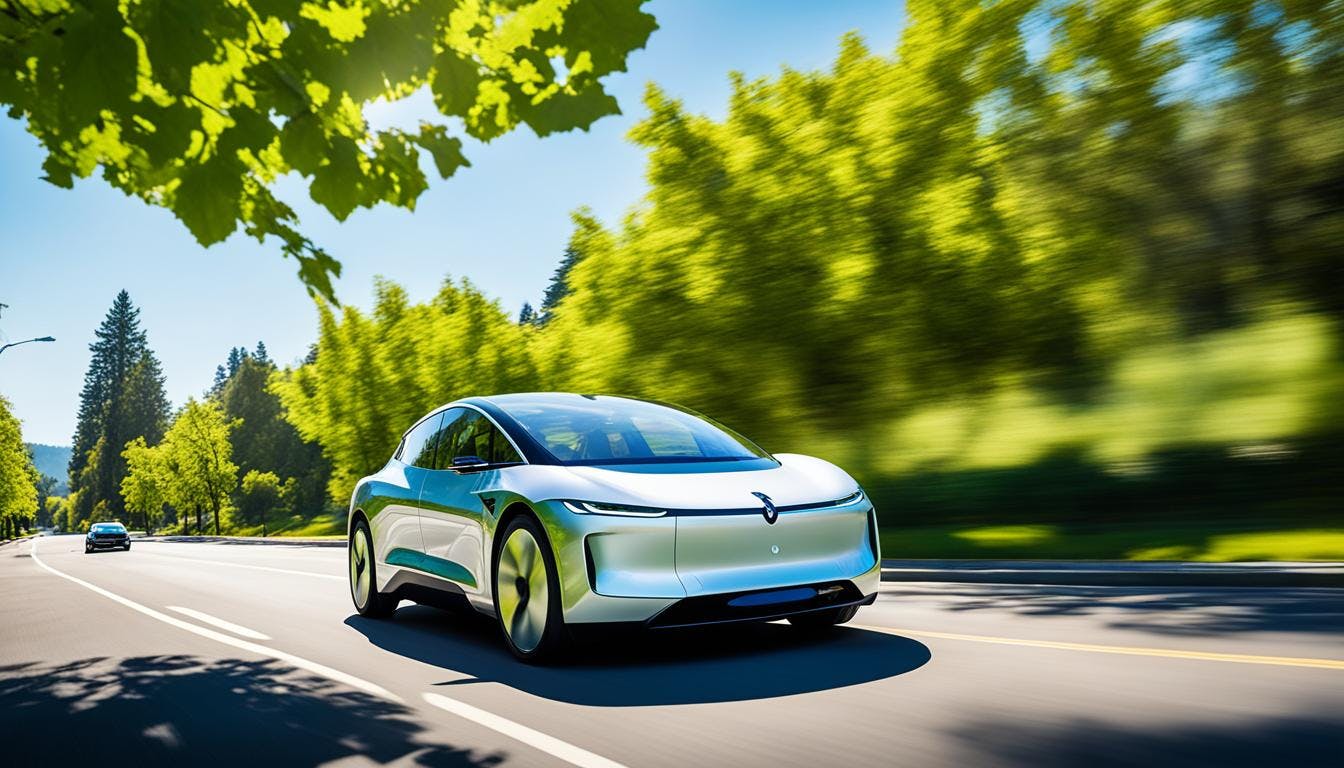
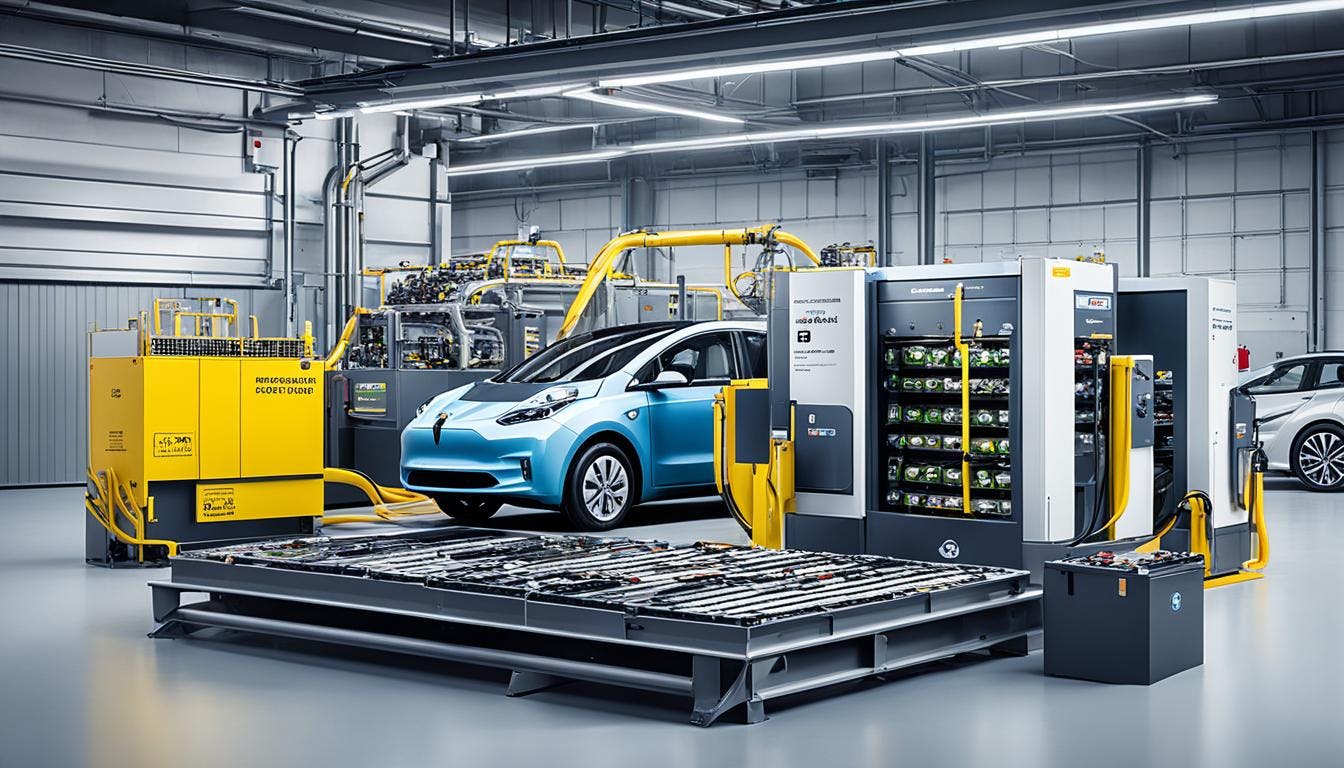
Recycling and Disposal of Electric Vehicle Batteries
Recycling and disposing of electric vehicle (EV) batteries are key to protecting our environment. These batteries last about 8 to 10 years. It's vital to use sustainable methods when they reach the end of their life.
EV batteries need replacing when they hold only 70% of their power and have been charged and discharged about 1,250 times. New battery recycling technology will be crucial in handling these old batteries.
The Current State of EV Battery Recycling Technology
EV battery recycling is getting better to meet tough environmental rules. In Europe, laws say EV batteries must have a certain amount of recycled materials. For instance, in 8 years, they must have at least 6% recycled lithium.
Europe wants to get up to 90% of materials like cobalt, copper, lead, and nickel from batteries by 2027. This goal will increase to 95% by 2031.
Efforts are underway to recycle almost all materials in lithium batteries. The recycling process can get back 70% to 90% of the battery’s weight, depending on its type. This ensures materials are reused, not wasted.
Challenges and Future Prospects in Battery Disposal
There are challenges in recycling EV batteries efficiently. One big issue is making sure 98.3% of lithium-ion batteries don't go to landfills. Landfills can cause fires and harm the environment. Currently, less than 5% of lithium batteries are recycled, unlike the 99% of lead car batteries in the US.
Recycling faces problems due to the complex nature of lithium-ion batteries and dangers from mining, like in the Democratic Republic of Congo. But, new battery recycling tech offers hope for the future. European rules will push manufacturers to recycle more EV batteries.
Looking ahead, better battery recycling tech will help protect our environment. By using sustainable practices, we can lessen the harm from battery disposal. This will make electric vehicles more sustainable for the future.
The role of Government policies in promoting Electric Vehicles
Government policies have been key in making electric vehicles (EVs) more popular. They offer subsidies and incentives and set strict rules to cut down on carbon footprint. Let's look at how these actions are changing the transport sector.
Subsidies and Incentives for EV Adoption
Worldwide, governments have given subsidies and incentives to EV makers and buyers. For example, the Bipartisan Infrastructure Law set aside $5 billion for EV charging stations on highways. The Inflation Reduction Act also extended a tax credit for EVs until 2032, including support for bidirectional charging.
Many states offer extra help to encourage more people to buy EVs. In fact, 47 states and Washington D.C. are helping with money and tax breaks for EVs. This support is key to growing EV use.
Regulations to Reduce Carbon Footprints
Rules have been crucial in reducing the carbon footprints of old cars. The U.S. government plans to spend $3 billion to make its fleet electric, starting with the U.S. Postal Service. This is part of a big plan to cut carbon footprint in public transport.
The Bipartisan Infrastructure Law also focuses on improving battery production and recycling with $6.135 billion. These rules help create a betterEV world, from making to recycling.
Some states follow California's lead on clean vehicle standards, speeding up the switch to cleaner transport. By 2030, many states want 30% of new heavy-duty EVs on the road. They hope to reach 100% by 2050.
With strong government policies, good subsidies and incentives, and strict regulations, moving to an electric future is getting easier.
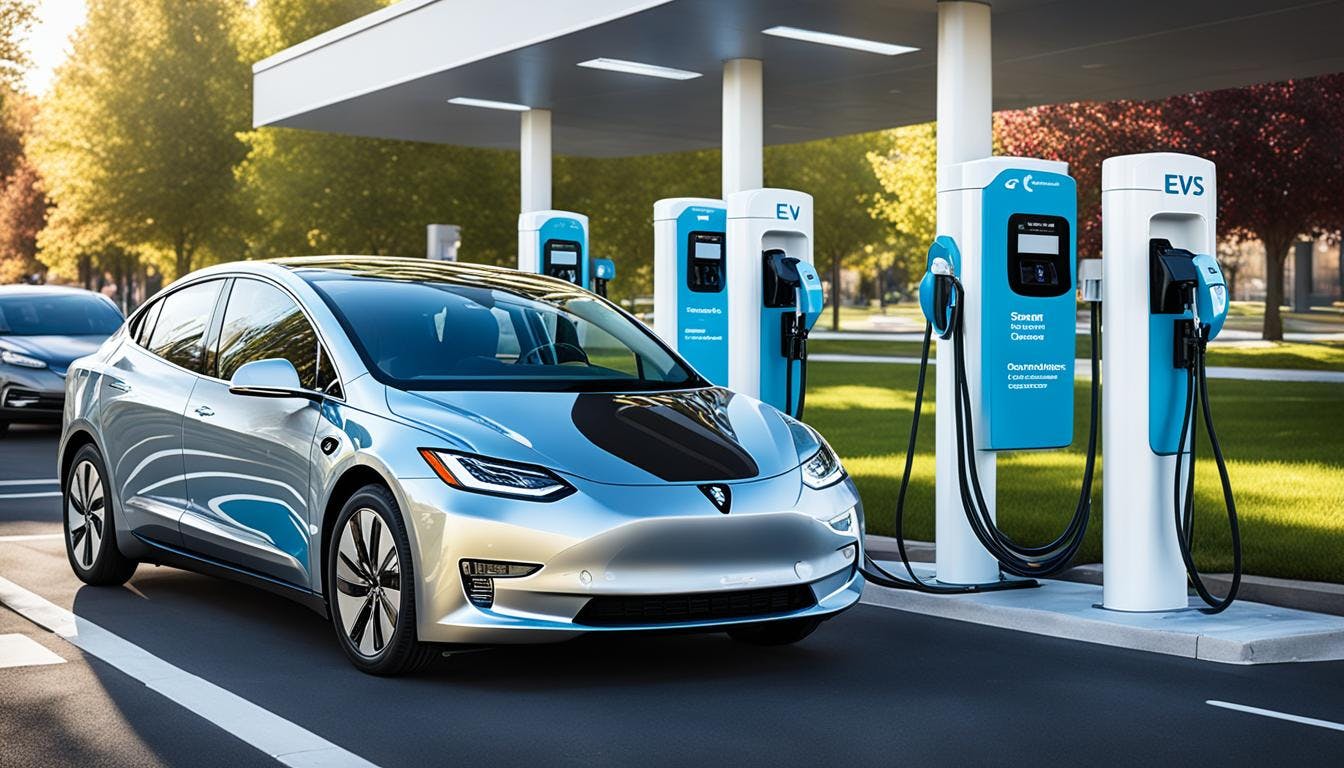
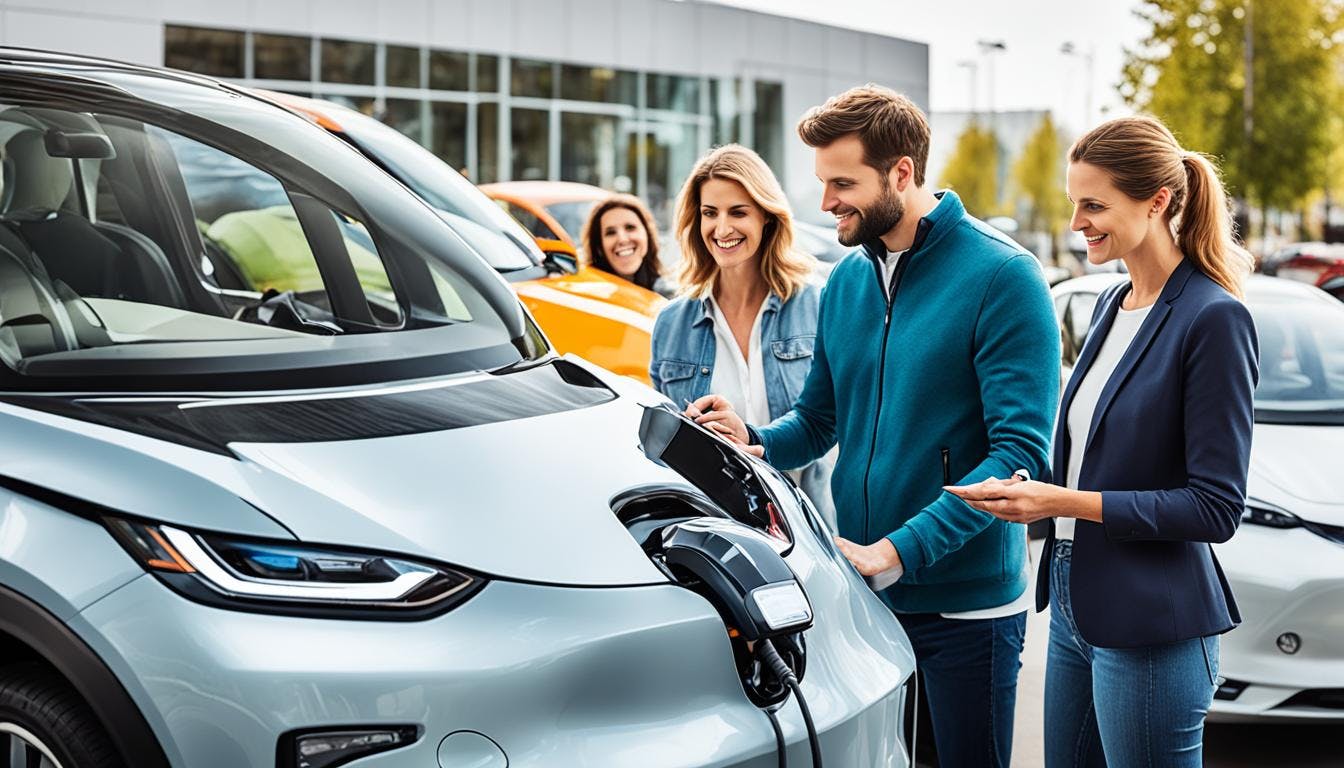
Public perception and the adoption of Electric Vehicles
As we talk more about climate change and sustainability, how people see electric vehicles (EVs) matters a lot. Recent figures show interesting changes in what people want and what's on the market. A big 38% of Americans might choose an EV for their next car, showing more people know about the good things EVs do for the planet. But, 50% of U.S. adults are still unsure, which is 4% less than in May 2022.
Market Trends and Consumer Preferences
In the last two years, EVs have become 8.5% of all new U.S. car sales, showing a move towards cleaner transport. Most potential EV buyers, 72%, want to help the environment, and 70% aim to cut down on gas costs. Those already driving hybrids or EVs, 68%, plan to keep choosing EVs next time. Yet, 17% of Americans doubt the country can build enough EV infrastructure, showing a need for more confidence.
Common Myths and Misconceptions About EVs
Many people are unsure about electric vehicles because of false beliefs. For example, 39% of Americans think EVs help combat climate change, but 59% don't support stopping new gas cars by 2035. Political views also affect how people see EVs. For example, 74% of Republicans question the U.S. building enough EV infrastructure, while 34% of Democrats are more hopeful. Clearing up wrong ideas about EVs' performance, cost, and how they affect the environment is key to getting more people on board.
What people think really shapes the future of electric vehicles. By highlighting the good things about electric cars and tackling concerns with clear info and strong infrastructure, we can make people more open to EVs.
FAQ's
What is the environmental impact of current generation electric vehicles?
Electric vehicles (EVs) are better for the environment than traditional cars. They use less energy and don't emit pollution when running on electricity. But, making them involves a lot of environmental harm, like mining for materials and making batteries.
How do electric vehicles help in the movement against climate change?
EVs cut down on greenhouse gases by using electric motors that are more efficient than old-style engines. When charged by renewable energy, they greatly reduce carbon emissions. This helps protect the environment.
What are the benefits of adopting electric vehicles?
EVs have many advantages. They produce fewer emissions, save money, and can run on clean energy. They also help make transport more efficient and improve city air quality.
What are the environmental concerns associated with raw material extraction for EVs?
Getting materials like lithium and cobalt for EV batteries can harm nature. It's important to mine these materials in a way that's good for the planet. We also need to find alternative materials to lessen the harm.
Why is battery manufacturing associated with high emissions?
Making batteries is energy-intensive and causes emissions. It needs a lot of electricity, often from sources that aren't good for the environment. This makes the process bad for the environment.
What challenges are involved in the assembly and production of electric vehicles?
Making EVs on a large scale is hard. It requires making production sustainable. This means using energy wisely, cutting waste, and managing the supply chain well.
How do electric vehicles compare to conventional vehicles in terms of carbon footprint?
EVs are generally better for the planet than traditional cars. They use energy more efficiently and don't emit pollution when on electricity. But, their impact also depends on where the electricity comes from.
What does a life cycle assessment of electric vehicles reveal?
A life cycle study shows EVs are generally better for the planet. It looks at the environmental effects from making the vehicle to its end. EVs come out as better and healthier, even with emissions from making electricity and disposing of batteries.
How does the method of electricity generation impact EV emissions?
The emissions from EVs depend on where the electricity comes from. Using clean energy like wind or solar power makes EVs much better for the planet. But, using electricity from fossil fuels makes them worse.
What are the advantages of using renewable energy sources for EV charging?
Using clean energy for charging EVs cuts down on fossil fuel use and emissions. It makes EVs better for the environment and helps reduce carbon emissions.
How do smart grids contribute to reducing EV emissions?
Smart grids use renewable energy better in the power grid. This makes charging EVs cleaner and supports sustainable transport. It's part of a bigger effort to use energy efficiently.
What are the current challenges in EV battery recycling technology?
Recycling EV batteries is tricky. We need to find ways to recycle them efficiently and safely. It also requires building a big recycling network.
What future prospects exist for the disposal of electric vehicle batteries?
The future looks bright for recycling EV batteries. We're working on better recycling tech and finding new uses for old batteries. Setting global recycling standards is also key to protecting the environment.
How do government policies promote the adoption of electric vehicles?
Governments help by offering money incentives and tax breaks for EVs. These policies aim to reduce pollution and encourage the use of clean energy.
What regulations are in place to reduce carbon footprints through EV adoption?
Laws set strict emissions limits for vehicles and support renewable energy. They also require car makers to produce more EVs. This helps lower carbon emissions overall.
What are the current market trends and consumer preferences regarding electric vehicles?
More people want EVs because they're good for the planet and save money. They also like the latest EV technology. This makes sustainable transport more popular.
What are common myths and misconceptions about electric vehicles?
Some think EVs have limited range and are expensive to charge. But, modern EVs have good range, more charging spots, and are cheaper to run than traditional cars.
17 South Street
Auckland 1010
New Zealand
info@carbonclick.com- -
- X
Sign up. Be inspired. Get clicking.
Subscribe now to stay up to date with CarbonClick, carbon offsetting and climate action.
By signing up you agree to our Privacy Policy.


